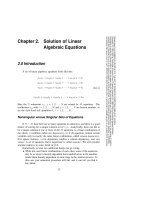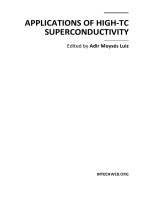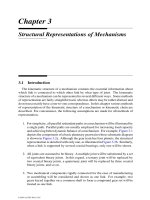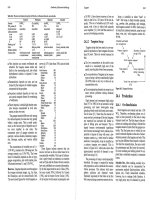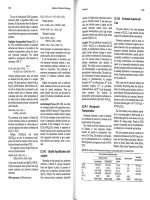Handbook of Advanced Interventional Cardiology - part 1 docx
Bạn đang xem bản rút gọn của tài liệu. Xem và tải ngay bản đầy đủ của tài liệu tại đây (1.54 MB, 68 trang )
MEDshare - High Quality Medical Resources -
Practical Handbook
of
Advanced Interventional Cardiology
Second edition
edited by
Thach N. Nguyen, MD, FACC, FACP, FSCAI
Editorial Consultant, Journal of Interventional Cardiology;
Co-editor, Journal of the Institute of Geriatric Cardiology ;
Professor of Medicine (Hon.)
Capital University of Medical Sciences
Beijing, China;
Director of Cardiology, Community Health Care System
St Mary Medical Center, Hobart, IN
Dayi Hu, MD
Professor of Medicine
Peking University and Capital University of Medical Sciences;
President, The Institute of Cardiovascular Diseases;
Chief of Cardiology, People and Beijing Tong Ren Hospital
Beijing, China
Shigeru Saito, MD, FACC, FSCAI, FJCC
Chief of Division of Cardiology and Catheterization Laboratories
Heart Center of Shonan Kamakura General Hospital
Heart and Great Vessel Center of Beijing You-Yi Friendship Hospital
Beijing, China
Cindy L. Grines, MD
Director, Cardiac Catheterization Laboratories
William Beaumont Hospital
Royal Oak, MI
Igor Palacios, MD
Director of Cardiac Catheterization Laboratories
and Interventional Cardiology
Massachusetts General Hospital
Boston, MA
Futura, an imprint of Blackwell Publishing
© 2001, 2003 by Futura, an imprint of Blackwell Publishing
Blackwell Publishing, Inc./Futura Division, 3 West Main Street, Elmsford,
New York 10523, USA
Blackwell Publishing, Inc., 350 Main Street, Malden, Massachusetts 02148-
5018, USA
Blackwell Publishing Ltd, 9600 Garsington Road, Oxford OX4 2DQ, UK
Blackwell Publishing Asia Pty Ltd, 550 Swanston Street, Carlton, Victoria
3053, Australia
All rights reserved. No part of this publication may be reproduced in any form
or by any electronic or mechanical means, including information storage and
retrieval systems, without permission in writing from the publisher, except by
a reviewer who may quote brief passages in a review.
First published 2001
Second edition 2003
Reprinted 2005
ISBN-13: 978-1-4051-1731-9
ISBN-10: 1-4051-1731-1
Library of Congress Cataloging-in-Publication data
Pra ct ica l ha nd b oo k of a dva nc ed int er ve nt io na l c ard iol og y /
[edited by] Thach Nguyen [et al.]. – 2nd ed.
p. ; cm.
Includes bibliographical references and index.
ISBN-13: 978-1-4051-1731-9
ISBN-10: 1-4051-1731-1
1. Heart – Surgery. 2. Heart – Endoscopic surgery. 3. Heart
– Di seas es – Tr eat me nt . I. N gu ye n, Thac h.
[DNLM: 1. Cardiac Surgical Procedures – methods – Hand-
books. 2. Cardiovascular Diseases – surgery – Handbooks.
WG 39 P895 2003]
RD598.P65 2003
617.4'12–dc21
2003013912
A catalogue record for this title is available from the British Library
Acquisitions: Jacques Strauss
Production: Charlie Hamlyn
Typesetter: Sparks
Printed and bound in India by Replika Press PVT Ltd
For further information on Blackwell Publishing, visit our websites:
www.futuraco.com
www.blackwellpublishing.com
iii
CONTRIBUTORS
Gérald Barbeau, MD
Laval Hospital, Institute de Cardiologie de Quebec, St Foy,
Quebec, Canada
Sarana Boonbaichaiyapruck, MD, FACC, FSCAI
Associate Professor of Medicine, Director, Cardiac Catheteri-
zation & Intervention Service, Ramathibodi Hospital, Mahidol
University, Bangkok, Thailand
Tan Huay Cheem, MD
Director, Coronary Intervention, The Heart Institute, Singa-
pore
Buxin Chen, MD
Vice-President, Chief, Cardiology Department, Beijing Diali
Hospital, Beijing, China
Zhang Shuang Chuan, MD
Director of Pediatric Department of Peking University Shen-
zhen Hospital, Professor of Pediatric Cardiology of Peking
University Hospital, Guest Professor of Shenzhen Children’s
Hospital, Shenzhen, China
Herbert Cordero, MD
Phoenix Heart Center at St Joseph Hospital and Medical
Center, Phoenix, AZ
Alain Cribier, MD
Department of Cardiology, Charles Nicolle Hospital, Univer-
sity of Rouen, France
Vijay Dave, MD
Chairman, Department of Medicine, Director of Medical
Education, Community Health Care System, St Mary Medical
Center, Hobart, IN
Edward Diethrich, MD
Medical Director, Arizona Heart Institute and Arizona Heart
Hospital, Phoenix, AZ
John S. Douglas, MD
Director of the Cardiac Catheterization Laboratories, Emory
University Hospital, Atlanta, GA
Ho Thuong Dzung, MD, PhD
Cardiology Department, Thong Nhat Hospital, Ho Chi Minh
City, Vietnam
Helene Eltchaninoff, MD
Department of Cardiology, Charles Nicolle Hospital, Univer-
sity of Rouen, France
Quan Fang, MD
Chief, Cardiology Department, Peking Union Hospital, Beijing,
China
iv Practical Handbook of Advanced Interventional Cardiology
Ted Feldman, MD, FACC, FSCAI
Professor of Medicine, Evanston-Northwestern Hospital,
Evanston IL
Kirk Garratt, MD
Interventional Cardiology, Mayo Clinics, Rochester, MN
C. Michael Gibson, MS, MD
Director TIMI Data Coordinating Center and Angiographic
Core Laboratory, Brigham and Women’s Hospital; Associate
Chief of Cardiology for Academic Affairs, Beth Israel Deacon-
ess Medical Center, Harvard Medical School, Boston, MA
Cindy Grines, MD
Director, Cardiac Catheterization Laboratories, William Beau-
mont Hospital, Royal Oak, MI
Lee Guterman, PhD, MD
Assistant Professor, Department of Neurosurgery, and Co-
Director, Toshiba Stroke Research Center, School of Medi-
cine and Biomedical Sciences, University at Buffalo, State
University of New York, Buffalo, NY
Richard Heuser, MD
Phoenix Heart Center at St Joseph Hospital and Medical
Center, Phoenix, AZ
Nguyen Lan Hieu, MD
Interventional Cardiologist, Vietnam Heart Institute, Hanoi,
Vietnam
L. Nelson Hopkins, MD
Professor and Chairman, Department of Neurosurgery;
Professor, Department of Radiology; and Director, Toshiba
Stroke Research Center; School of Medicine and Biomedical
Sciences, University at Buffalo, State University of New York,
Buffalo, NY
Jay Howington, MD
Assistant Clinical Instructor of Neurosurgery and Neuroen-
dovascular Fellow, Department of Neurosurgery and Toshiba
Stroke Research Center, School of Medicine and Biomedical
Sciences, University at Buffalo, State University of New York,
Buffalo, NY
Dayi Hu, MD
Professor of Medicine, Peking University and Capital Univer-
sity of Medical Sciences; President, The Institute of Cardio-
vascular Diseases; Chief of Cardiology, People and Beijing
Tong Ren Hospital, Beijing, China
Do Quang Huan, MD
Director, Cardiac Catheterization Laboratories, The Heart
Institute, Ho Chi Minh City, Vietnam
Jui Sung Hung, MD
Professor of Medicine, China Medical College, Taichung,
Taiwan
Contributors v
Pham Manh Hung, MD
Associate Director, Cardiac Catheterization Laboratories,
Vietnam Heart Institute, Bach Mai Hospital, Hanoi Medical
University, Hanoi, Vietnam
Greg L. Kaluza, MD, PhD
Scientifi c Director, Institute for Research in Cardiovascular In-
terventions, The Methodist DeBakey Heart Center and Baylor
College of Medicine, Houston, TX
Huynh Tuan Khanh, MD
Pediatric Cardiologist, Pediatric Hospital #2, Ho Chi Minh
City, Vietnam
Moo-Huyn Kim, MD
Director, Cardiac Catheterization Laboratory, Dong-A Univer-
sity Hospital, Busan, Korea
Rajiv Kumar
Illinois Institute of Technology, Chicago IL
Kean Wah Lau, MB, FACC
Singapore Heart Institute, Singapore
Wang Lei, MD
Director, Catheterization Laboratories of the Heart & Blood
Vessel Center, Beijing Friendship Hospital, Beijing, China
Elad Levy, MD
Assistant Clinical Instructor of Neurosurgery and Neuroen-
dovascular Fellow, Department of Neurosurgery and Toshiba
Stroke Research Center, School of Medicine and Biomedical
Sciences, University at Buffalo, State University of New York,
Buffalo, NY
Rijie Li, MD
Vice-President, Chief, Cardiology Department, Chui Yang Liu
Hospital, Beijing, China
Tianchan Li, MD
Vice Director, The Heart Center, Beijing Tongren Hospital,
Beijing, China
Meilin Liu, MD
Chief, Cardiology Department, Beijing Tongren Hospital,
Capital University of Medical Sciences, Beijing, China
Do Doan Loi, MD, PhD
Director of the Echocardiography Laboratories, Vietnam
Heart Institute, Hanoi, Vietnam
Caiyi Lu, MD
Professor and Vice-Director of Institute of Geriatric Cardiol-
ogy, Chinese PLA General Hospital, Beijing, China
Nithi Mahanonda, MD, FRACP, FACC, FSCAI, FACA
Associate Director, Bangkok Heart Institute, Bangkok Gen-
eral Hospital, Bangkok, Thailand
Kazuaki Mitsudo, MD
Chief of Cardiology, Department of Cardiology, Kurashiki
Central Hospital, Japan
vi Practical Handbook of Advanced Interventional Cardiology
Phillip Moore, MD
Associate Professor of Pediatrics, Director of Pediatric Con-
genital Heart Disease Program, UCSF, San Francisco, CA
Nguyen Thuong Nghia, MD
Interventional Cardiology Unit, Cho Ray Hospital, Ho Chi
Minh City, Vietnam
Thach Nguyen, MD, FACC, FACP, FSCAI
Editorial Consultant, Journal of Interventional Cardiology;
Co-editor, Journal of the Institute of Geriatric Cardiology ; Pro-
fessor of Medicine (Hon.), Capital University of Medical Sci-
ences, Chao Yang and Friendship Hospital, Beijing, China;
Director of Cardiology, Community Health Care System, St
Mary Medical Center, Hobart, IN
Phong Nguyen-Ho, MD
Interventional Cardiology Fellow, University of Toronto, Uni-
versity Health Network – Toronto General Hospital Campus,
Toronto, Canada
Vo Thanh Nhan, MD, PhD
De p ut y He a d o f t h e De p ar tmen t o f Car d iolo g y, H e ad of t he I n -
terventional Cardiology Unit, Cho Ray Hospital, Ho Chi Minh
City, Vietnam; Senior Lecturer, Faculty of Medicine, Univer-
sity of Medical Sciences, Ho Chi Minh City, Vietnam
Igor Palacios, MD
Director of Cardiac Catheterization Laboratories and In-
terventional Cardiology, Massachusetts General Hospital,
Boston, MA
Seung Jung Park, MD
Chief, Division of Cardiology, Asan Medical Center, University
of Ulsan, Seoul, Korea
Loan Pham, MD
McLaren Regional Medical Center, Flint, MI
Ta Tien Phuoc, MD
Cardiology Consultant, Vietnam Heart Institute, Hanoi, Viet-
nam
Devan Pillay, MD
Consultant Interventional Cardiologist, Gleneagles Medical
Centre, Kuala Lumpur, Malaysia
Nguyen Ngoc Quang, MD
Interventional Cardiologist, Vietnam Heart Institute, Hanoi,
Vietnam
Kasja Rabe, MD
Med. Cand., Cardiovascular Center, Frankfurt, Germany
Mark Reisman, MD
Director of Cardiovascular Research, Swedish Medical
Center, Seattle, WA
Gianluca Rigatelli, MD, FSCAI, FCCP, FESC
Interventional Cardiologist, Endovascular Therapy Research,
Legnago, Verona, Italy
Contributors vii
Shigeru Saito, MD, FACC, FSCAI, FJCC
Chief of Division of Cardiology and Catheterization Labora-
tories, Heart Center of Shonan Kamakura General Hospital,
Heart and Great Vessel Center of Beijing You-Yi Friendship
Hospital, Beijing, China
Jia Sanqing, MD, PhD
Director, Heart & Blood Vessel Center, Beijing Friendship
Hospital, affi liated to Capital University of Medical Sciences,
Beijing, China
Lihua Shang, MD
Director, Cardiac Catheterization Laboratories, The People’s
Hospital, Beijing, China
Samuel J. Shubrooks, Jr, MD
Associate Professor of Medicine, Harvard Medical School,
Co-Director of the Cardiac Catheterization Laboratories, Beth
Israel Deaconess Medical Center, Boston, MA
Horst Sievert, MD
Professor of Medicine, Cardiovascular Center, Frankfurt,
Germany
Krishna Rocha Singh, MD
Director Vascular Medicine Program, Clinical Assistant Pro-
fessor of Medicine, Southern Illinois University, School of
Medicine, Springfi eld, IL
Yan Songbiao, MD
Vice Director, Heart & Blood Vessel Center, Beijing Friendship
Hospital, affi liated to Capital University of Medical Sciences,
Beijing, China
Pham Hoan Tien, MD
Cardiology Consultant, Vietnam Heart Insitute, Hanoi, Viet-
nam
David Teitel, MD
Professor of Pediatric, Chief of Pediatric Cardiology, UCSF,
San Francisco, CA
Damras Tresukosol, MD
Associate Professor of Medicine, Director of Cardiac Cath-
eterization Laboratories, Faculty of Medicine, Siriraj Hospital,
Bangkok, Thailand
Christophe Tron
Department of Cardiology, Charles Nicolle Hospital, Univer-
sity of Rouen, France
Nguyen Quang Tuan, MD
Interventional Cardiologist, Vietnam Heart Institute, Hanoi,
Vietnam
Mintu Turakhia, MD
Internal Medicine Resident, Brigham and Women’s Hospital,
Harvard Medical School, Boston, MA
viii Practical Handbook of Advanced Interventional Cardiology
Lefeng Wang, MD
Deputy Director of the Cardiology Center, Director of the Cath-
eterization Laboratories and Associate Professor, Chaoyang
Red Cross Hospital, Beijing, China
Shiwen Wang, MD, MCAE
Member of Chinese Academy of Engineering, Professor and
Director of the Institute of Geriatric Cardiology, Chinese PLA
General Hospital, Beijing, China
Guy Weigold, MD
Fellow, Division of Cardiology, Washington Hospital Center,
Washington, DC
Neil J Weissman, MD
Director, Cardiac Ultrasound, Cardiovascular Research Insti-
tute, Washington Hospital Center, Washington, DC
Hong Zhao, MD
Cardiology Department, The People’s Hospital, Peking Uni-
versity, Beijing, China
Mingzhong Zhao, MD
Cardiology Department, The People’s Hospital, Peking Uni-
versity, Beijing, China
ix
FOREWORD
Interventional cardiovascular medicine has evolved from an
extremely crude method of opening femoral arteries initiated
by Dotter, to a fi eld that has now been recognized as having
a suffi cient fund of knowledge to require boards sanctioned
by the American Board of Internal Medicine. From Andreas
Gruentzig’s development of the noncompliant balloon meth-
od, we have seen an explosion of bioengineering technology.
The discipline of interventional cardiovascular medicine has
perhaps initiated more registries and clinical trials than any
other discipline in medicine. Indeed, the whole emphasis
on evidence-based medicine has evolved during the era of
interventional cardiology. Many basic science breakthroughs
have been stimulated by the advances produced in interven-
tional cardiology, as well as the problems and complications
created by the new technologies.
However, no matter how advanced the science becomes,
the success of solving a patient’s problem with interventional
techniques usually depends on the operator’s technical abil-
ity. This ability springs from the wealth of experience the
operator has acquired to deal with routine situations as well
as complex and almost unique problems that may present
themselves. Because of the large number of interventional
cardiologists and the rapidly expanding number of proce-
dures that can be performed, it is diffi cult for many cardiolo-
gists to experience all of the situations that can be helpful in
building this database.
Dr Thach Nguyen has prepared a remarkable book, rich
with tips and tricks for performing interventional cardiovascu-
lar medicine procedures. He has enlisted numerous experts
on various aspects of interventional cardiovascular medicine
to describe their areas of expertise. Rather than let them re-
cite the evidence from registries and trials that are available
elsewhere, he forces the contributors to provide the practical
tips that they have learned. It is almost as though Dr Nguyen
is trying to simulate the type of scenarios that exist in the
catheterization laboratories with new cardiology fellows or
less experienced operators. It is the type of advice that he has
often given to cardiologists in developing countries who are
br in g in g inte r ve nti on a l te c hn iq u es t o hel p co pe w it h the r ap id -
ly expanding new threat in these countries, vascular disease.
Since new techniques are constantly appearing, all opera-
tors, experienced or not, can benefi t from these tips. Whereas
every operator will not agree with every approach to a problem
or a complication, it is always instructive to understand many
potential approaches. In this regard, the book does a mas-
terful job of collecting not only the authors’ experiences, but
those of many others collected from the published literature,
x Practical Handbook of Advanced Interventional Cardiology
from numerous postgraduate courses, and from one-on-one
demonstrations throughout the world.
This book should be a valuable resource to trainees in for-
mal programs that have now evolved in the United States and
other countries, as well as the many preceptorships that are
the major means of training in other countries. In addition, op-
erators of all levels of experience will fi nd many useful pearls
of wisdom. Dr Nguyen and his colleagues are to be congratu-
lated for compiling this most practical guide.
Spencer B. King III, MD
Atlanta, Georgia
xi
PREFACE
ADVANCED INTERVENTIONAL CARDIOLOGY:
ART OR SCIENCE?
In 2003, more than 20 years after its humble beginning,
interventional cardiology is a mature and major player in the
management of complex cardiovascular problems. Its goals
are to improve the symptoms, sustain the positive acute gains,
and prolong life. The politically correct challenge is how to ap-
ply it at a universally affordable price to the American elderly
patient population living on retirement benefi ts (without bank-
rupting Medicare) or to the fi nancially struggling patients in
developed or developing countries.
The technique of any procedure is formulated as a
sequence of rigorously controlled maneuvers. They can
be taught to fellows or staff, or programmed into robots. To
understand and explain the physical, chemical, or biologic
mechanism of any of these techniques or maneuvers is a sci-
ence. To perform a procedure cost- and time-effectively in a
humane manner is an art. In any interventional laboratory, a
lesion could be dilated with one guide, one wire, one balloon,
and/or one stent (if no predilation). A similar lesion can fi nally
be dilated by a beginner after using any number of guides,
wires, balloons, or stents. This is what experience is for. The
bottom line is how to perform the procedure without wasting
equipment, the patient’s, the physician’s, and staff’s time, and
causing no further harm (e.g. radiation). The goals of any pro-
cedure are highlighted in Table 0-1.
Which is the best option applying to this real-life
situation?
While performing a procedure, every operator has the
luxury to select, to change, or to delete a strategy, a device,
or a drug (or be forced to use ones because the others are not
available) from many options in order to achieve a procedural
or clinical success. These options are listed plentifully and
available anywhere in the printed or electronic media. How-
ever, the main question is always: which one is the best option
applying to this real-life situation, with the equipment available
here? In the second edition of this handbook, the authors try to
answer that question and give practical suggestions derived
from their own daily labor in the cardiac catheterization labo-
ratories (or, as we call it intellectually, “experience”). So we
highlight these practical heart-to-heart suggestions as Best
Method, along with First Maneuver, Second Maneuver, or Ca-
veat or Take-Home Message with all of the dramatic colorings
or ups and downs – reminiscent of an Italian opera – which
xii Practical Handbook of Advanced Interventional Cardiology
happen many times in every cardiac catheterization labora-
tory. However, we hope the outcome is always as beautiful as
any Chinese kung-fu movie.
In this way, the authors try to show how to select an appro-
priate device (best choice among many) so it can achieve its
goal on the fi rst attempt. Once a device does not function as it
ideally should, there are many simple maneuvers (best meth-
ods among many) whereby the operators try to exhaust the
full potential of a device before throwing it away or replacing
it. In the end, the success rate is high due to improvements of
technology, drugs, operator experience, and effort, and so are
the expectations of the patient and family. The complication
rate may be lower due to prevention and vigilant attention of
the operators, or higher due to case selection (more high-risk
patients and complex lesions). In any situation, once compli-
cations occur, they should be recognized early and damage
control protocol should be promptly applied. This is why, in
this second edition, we have the Caveats or Take-Home Mes-
sages to remind the young and old, beginner or experienced
operators, of what to do in stressful situations or how to pre-
vent them arising.
To the readers, who are all friends and colleagues
The authors and editors, who are all your friends and
colleagues, labor every day in the cardiac laboratories like
you. We write from our limited experience and our heart, dur-
ing many sleepless nights. This handbook contains practical
heart-to-heart advice aimed at you, the readers, and at us, the
authors ourselves: we practice what we preach. These pieces
of advice are applied daily in our laboratories or from those of
authors we quote, and hopefully in your laboratories. They are
not from an ivory tower. They are practiced by the experienced
Table 0-1 Strategic goals during interventions
1. Effectiveness: Problems controlled and results sus-
tained
2. User-friendly performance: Simple manipulations,
single operator, low-profi le device, and no complex and
costly set-up
3. Cost- and time-effective selection of device: A device
should be selected appropriately to achieve its goal at the
fi rst try
4. Cost- and time-effective approach: In an attempt to
fi x or reverse a problem, it is more cost- and time-effec-
tive to manipulate devices currently in place rather than
exchange them for new equipment
5. Low complication rate: Anticipation of complications,
rigorous prevention, early detection, and prompt damage
control.
Preface xiii
and the beginners, by the young and old, by men and women,
so there is no question of class, age or sex or race division
here, all of us are equal in striving to achieve procedural or
clinical success.
Acknowledgements
As editors and authors, we hope we achieve our role as
effective communicators to our readers who are all friends
and colleagues. For the completion of this handbook, we
owe much to our families, friends and colleagues. From the
rural cornfi elds of northwest Indiana, I (TNN) am indebted for
the invaluable encouragement of SJ Morales (Chicago), my
parents, Mr Nguyen Ngoc Sau and Mrs Tran Thi Hong Hanh
(Laporte IN); and Mr Milt Triana, Administrator of Health Com-
munity System, St Mary Medical Center, Hobart IN. It has
been a privilege having the special support of Mr Jacques
Strauss, Vice-President of Blackwell.
We really appreciate the help and efforts of the staffs at
St Mary Medical Center (Hobart IN), Cheryl Anderson RT,
Manager, Suzi Emig RN, Jennifer Fraley RT, Jennifer Gould
RT, Karen Filko RT, Char King RN, Pat Robinson RN, Kris
Shocaroff RN, and Debbie Smith RN; at Methodist Hospital,
Southlake and Northlake campuses (Merrillville and Gary IN)
Susan Slivka RT, Thomas Thegze RT, Lynetter Taylor RT,
Patt Patzke RN, Judy Rataczak RN, Kim Grantsaris RT, Brad
Johnson RT, and Erica Myller RT; and at St Anthony Hospi-
tal and Medical Center, Linda Rempala RN, BSN, BC, Tom
Swendenberg RN, BSN, Suzan Taylor RN, Jim Campagna
RT, Penny Ballestero RT, and Darlene Cusick RN. Many an-
giographic fi gures and technical tips are taken from cases in
the cardiac catheterization laboratories of: Beijing Tong Ren
Hospital; Beijing Friendship Hospital; Shonan Kamakura
Hospital in Kamakura, Japan; China Medical College Hos-
pital in Tai Chung, Taiwan; Vietnam Heart Institute, Hanoi,
Vietnam; The Heart Institute, Ho Chi Minh City, Vietnam; The
National University Hospital, Singapore; and Dong A Medical
Center, Busan, Korea.
Above all, we are indebted to our patients, the purpose of
our care, the source of our quests, and the inspiration of our
daily works. To them, we give our heartfelt thanks.
xv
CONTENTS
Contributors iii
Foreword ix
Preface xi
Abbreviations xix
Chapter 1 Vascular Access
Thach Nguyen, Rajiv Kumar 1
Chapter 2 Transradial Approach
Gérald R Barbeau 17
Chapter 3 Angiographic Views
Thach Nguyen, Ta Tien Phuoc,
Gianluca Rigatelli 25
Chapter 4 Guides
Thach Nguyen, Nguyen Thuong Nghia,
Vijay Dave 63
Chapter 5 Wires
Thach Nguyen, Lihua Shang 93
Chapter 6 Balloon Angioplasty
Thach Nguyen, Nguyen Ngoc Quang,
Huan Quang Do, Meilin Liu, Rijie Li 109
Chapter 7 Stenting
Thach Nguyen, Jia Sanqing, Wang Lei,
Yan Songbiao 123
Chapter 8 High-risk Patients
Thach Nguyen, Nithi Mahanonda,
Tianchan Li, Sarana Boonbaichaiyapruck 153
Chapter 9 Complex Lesions
Thach Nguyen, Cayi Lu, Shiwen Wang 181
Chapter 10 Chronic Total Occlusion
Kazuaki Mitsudo, Thach Nguyen,
Jui Sung Hung 203
Chapter 11 Ostial Lesions
Thach Nguyen, Ho Thuong Dzung,
Devan Pillay, Buxin Chen, Quan Fang 221
Chapter 12 Acute ST-elevation Myocardial Infarction
Thach Nguyen, Mintu Turakhia, Pham Hoan
Tien, Wang Lefeng, C Michael Gibson 229
Chapter 13 Bifurcation Lesions
Samuel J Shubrooks, Jr 259
Chapter 14 Approach to the Patient with
Prior Bypass Surgery
John S Douglas, Thach Nguyen,
Loan Pham, Tan Huay Cheem 279
xvi Practical Handbook of Advanced Interventional Cardiology
Chapter 15 Left Main Lesions
Seung Jung Park, Thach Nguyen 301
Chapter 16 Removal of Embolized Material
Kirk Garratt, Thach Nguyen 319
Chapter 17 Complications
Thach Nguyen, Damras Tresukosol,
Vo Thanh Nhan, Mingzhong Zhao,
Hong Zhao 335
Chapter 18 Vascular Brachytherapy and Restenosis
Moo-Hyun Kim, Phong Nguyen-Ho,
Thach Nguyen, Greg L Kaluza 361
Chapter 19 Rotational Atherectomy
Thach Nguyen, Mark Reisman,
Ted Feldman 379
Chapter 20 Intravascular Ultrasound
Guy Weigold, Neil J Weissman 391
Chapter 21 Percutaneous Ilio-femoral
Revascularizations
Krishna Rocha Singh 407
Chapter 22 Carotid Artery Interventions
Kasja Rabe, Herbert Cordero,
Richard Heuser, L Nelson Hopkins,
Horst Sievert 429
Chapter 23 Endovascular Abdominal Aortic
Aneurysm Exclusion
Edward B Diethrich 467
Chapter 24 Inoue Balloon Mitral Valvuloplasty
Jui-Sung Hung, Nguyen Quang Tuan,
Pham Manh Hung, Moo Hyun Kim,
Kean Wah Lau 485
Chapter 25 Percutaneous Mechanical Mitral
Commissurotomy
Alain Cribier, Helene Eltchaninoff 523
Chapter 26 Retrograde Balloon Percutaneous
Aortic Valvuloplasty
Ted Feldman 541
Chapter 27 Percutaneous Implantation of
Aortic Valve Prosthesis
Alain Cribier, Helene Eltchaninoff,
Christophe Tron 551
Chapter 28 Interventions in Intracranial Arteries
Jay U Howington, Elad I Levy,
Lee R Guterman, L Nelson Hopkins 567
Contents xvii
Chapter 29 Percutaneous Interventions in
Adults with Congenital Heart Diseases
Phillip Moore, Huynh Tuan Khanh,
Zhang Shuang Chuan, Nguyen Lan Hieu,
David Teitel 591
Index 641
xix
Abbreviations Used in This Book
ACS = acute coronary syndrome
ACT = activated clotting time
AP = anteroposterior
ASD = atrial septal defect
ATM = atmosphere(s)
AVF = arteriovenous fi stula
BP = blood pressure
CABG = coronary artery bypass graft
CAD = coronary artery disease
CBF = coronary blood fl ow
CCA = common carotid artery
CEA = carotid endarterectomy
CFA = common femoral artery
CHD = congenital heart disease
CTO = chronic total occlusion
DCA = directional coronary atherectomy
DES = drug-eluting stent
ECA = external carotid artery
ECG = electrocardiogram
Gy = gray
IABP = intra-arterial balloon pump
ICH = intracranial hemorrhage
IMA = internal mammary artery
IRA = infarct-related arteries
ISMN = isosorbide mononitrate
ISR = in-stent restenosis
IVUS = intravascular ultrasound
LA = left atrium; left atrial
LAD = left anterior descending artery
LAO = left anterior oblique
LCX = left circumfl ex coronary artery
LIMA = left internal mammary artery
LM = left main
LMWH = low molecular weight heparin
LUPV = left upper pulmonary vein
LV = left ventricle
MACE = major acute cardiovascular event
MCA = middle cerebral artery
MI = myocardial infarction
MLD = minimal lumen diameter
OM = obtuse marginal
PA = pseudoaneurysm
PCI = percutaneous coronary intervention
PCWP = pulmonary capillary wedge pressure
PDA = posterior descending artery
PET = positron-emission tomography
PFA = profunda femoral artery
PICA = posterior inferior cerebellar artery
xx Practical Handbook of Advanced Interventional Cardiology
PMMC = percutaneous mechanical mitral commissurotomy
POBA = plain balloon angioplasty
psi = pounds per square inch
PT = prothrombin time
PTA = peripheral transluminal angioplasty
PTCA= percutaneous transluminal coronary angioplasty
PTRA = percutaneous transluminal rotational atherectomy
PTT = partial thromboplastin time
PWI = perfusion weighted imaging
RAO = right anterior oblique
RCA = right coronary artery; radial artery compression
ROTA = rotational atherectomy
RUPV = right upper pulmonary vein
RV = right ventricle; right ventricular
SCA = single coronary artery
SFA = superfi cial femoral artery
SVG = saphenous vein graft
TEE = transesophageal echocardiography
TLA = translumbar access needle
TLR= target lesion revascularization
TMR = transmyocardial revascularization
TRA = transradial approach
TVR = target vessel revascularization
VBT= vascular brachytherapy
VT = ventricular tachycardia
1
Chapter 1
Vascular Access
Thach Nguyen, Rajiv Kumar
Femoral access: Standard technique
*Preparations in obese patients
*Directing the needle
*If the wire cannot be inserted
*Sequential order for arterial and venous puncture
**Puncture of pulseless femoral artery
***Puncture in cyanotic patients
**Insertion and removal of IABP through diseased iliac
artery
Puncture of femoral bypass graft
**Puncture location
**Angle of introduction
**Sequential dilation
**Kinked wire
Closure devices
***Pre-closure of large arterial access
***Non-surgical removal of the AngioSeal device
TAKE-HOME MESSAGE: What to do if collagen is in-
serted intra-arterially
***When to suspect intra-arterial deployment of collagen
plug
Antegrade puncture
**Antegrade puncture
**Manipulation of wire
**Puncture of CFA with high bifurcation
**Puncture with abduction and external rotation of the
thigh
Brachial approach
Translumbar approach
***Reverse image
Transseptal approach
***Manipulation of catheter
*Basic; **Advanced; ***Rare, exotic, or investigational.
From: Nguyen T, Hu D, Saito S, Grines C, Palacios I (eds), Practical
Handbook of Advanced Interventional Cardiology, 2nd edn. © 2003
Futura, an imprint of Blackwell Publishing.
2 Practical Handbook of Advanced Interventional Cardiology
Complications
**Mechanical thrombectomy for acute thrombosis
**Thrombolytic therapy for acute thrombosis
**Different patterns of ultrasound in the differential diag-
nose s of ac c e s s site swelling
BEST METHOD: Best choice for management of pseu-
doaneursym
FEMORAL ACCESS: STANDARD TECHNIQUE
Locate the femoral artery and inguinal ligament that runs
from the anterior superior iliac spine to the pubic tubercle. The
true position of the inguinal ligament is 1–2 cm below that
line.
1
The femoral pulse at the inguinal crease is not a reliable
landmark for the common femoral artery (CFA), particularly
in obese patients.
2
Ninety-seven percent of patients have the
femoral artery lying on the medial third of the femoral head.
Only 3% have the artery totally medial to the femoral head.
3
TECHNICAL TIPS
*Preparations in obese patients: The femoral pulse at
the inguinal crease is not a reliable landmark for the com-
mon femoral artery (CFA), particularly in obese or elderly
patients, whose crease tends to be much lower than the in-
guinal ligament.
2
The protruding abdomen and panniculus
should be retracted, and taped to the chest with 3- to 4-inch
tapes that are in turn secured to the sides of the catheter-
ization table. Keep the tissue layer above the artery as thin
and as taut as possible, so the needle will not be defl ected
outside the projected angle and selected pathway.
*Directing the needle: Once the needle tip is near the ar-
tery, it tends to pulsate except in patients with severe local
scarring (after many prior remote femoral artery cannula-
tions, ilio-femoral bypass, after total hip replacement, etc.). If
the hub inclines to the right, the needle should be withdrawn
by 1 or 2 cm and the tip redirected to the left before advancing
forward. If the hub inclines to the left side, the reverse ma-
neuver is used to change the course. If the needle pulsates
on the vertical axis, it just needs to be inserted more deeply.
3
*If the wire cannot be inserted: Most often, this is because
the needle hit the contralateral wall. Just move the needle
by a slight pull or rotate it a little, and the wire may be able
to be inserted. If there is diffi culty, it is better to withdraw
the needle and re-puncture the artery rather than dissect
the artery.
4
After the sheath is inserted and the wire is not
able to negotiate the tortuous iliac artery then a diagnostic
Judkins right catheter can be advanced to the tip of the
Vascular Access 3
wire in order to help steer the wire tip. A gentle injection of
contrast may help to delineate the anatomy and determine
the reason why the wire could not be advanced. The use
of hydrophilic wires for the initial introduction through the
needle should be avoided because they can easily travel
subintimally and cause later dissection. Also, they can be
easily cut by the sharp needle tip.
*Sequential order for arterial and venous puncture:
The order of arterial and venous access is often a matter
of personal preference. We prefer to puncture the vein
fi rst and insert a wire inside the vein to secure the access.
Then, less than 1 minute later, after puncturing the artery,
we would insert the sheath into the artery and the vein. Be-
cause there is only a wire in the vein, we do not disturb the
anatomic landmark of the common femoral artery, which
we try to locate and puncture. Less than 1 minute without
a sheath will not produce a hematoma at the venous site.
If the artery is inadvertently punctured fi rst, we would can-
nulate the artery, then puncture the vein under fl uoroscopy,
with the needle medial and parallel to the arterial sheath.
**Puncture of pulseless femoral artery: As usual, the
artery should be punctured over the middle of the medial
third of the femoral head. Localize the skin puncture site
by fl uoroscopy just below the inferior border of the femoral
head in order to prevent high punctures that may lead to
uncontrollable bleeding. However, these proportions are
valid only in the AP, neutral position (Figure 1-1). Internal
or external rotation of the femur can considerably change
the relationship of the femoral artery to the femoral head.
5
Doppler guidance is very helpful in puncturing an artery
with very weak pulse or a pulseless artery, especially when
the standard anatomy is deranged by a large hematoma, or
thick scar after surgery. The most common cause of weak
pulse is hypovolemic hypotension, heavy calcifi cation, and
is only rarely due to narrow pulse pressure such as in con-
strictive pericarditis (in contrast to aortic regurgitation).
***Puncture in cyanotic patients: In children with cya-
notic heart disease, especially those weighing less than
15 kg and with severe polycythemia, the blood fl ow from a
femoral puncture can resemble a venous sample: a gentle
fl ow of dark blood. This color is due to arterial desaturation
and hyperviscosity secondary to polycythemia. If there is
doubt, confi rm the arterial puncture by attaching the needle
to a pressure transducer or by making a small contrast in-
jection into the arterial lumen.
6
***Insertion and removal of IABP through diseased
iliac artery: When an IABP needs to be inserted and an
4 Practical Handbook of Advanced Interventional Cardiology
iliac lesion is found, the lesion should be dilated fi rst. Insert
the balloon pump, then perform stenting of the lesion later
after the IABP is removed. When a balloon pump is to be in-
serted through a previously stented iliac artery, do it under
fl uoroscopy to be sure the balloon does not get stuck on the
stent struts. To remove the IABP defl ated balloon, insert a
large femoral sheath and withdraw the winged balloon into
the sheath so the folds of the winged balloon are not caught
by struts at the stent edges. Chronic endothelialization of
the stent struts should diminish this problem.
PUNCTURE OF FEMORAL BYPASS GRAFT
The problems involving puncture of an old vascular graft
in the femoral area include: uncontrollable bleeding and
Figure 1-1: Needle position on the femoral head for arterial
and venous puncture and cannulation.
